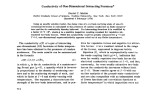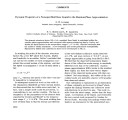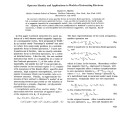|
|
Creator | Title | Description | Subject | Date |
| 51 |
 |
Mattis, Daniel C. | Second-order phase transition in a model random alloy | We investigate the existence and stability of long-range order in a simple model of a binary alloy. We find that for electron concentrations in the vicinity of one per atom, in bipartite lattices, long-range order of the atoms exists at low temperatures, and we find that the system undergoes a secon... | Phase transition; Random alloys; Quasiparticles; Density of state | 1973-03 |
| 52 |
 |
Mattis, Daniel C. | Phonons and phase transitions of helium | We find a new collective shear-wave-like mode above Tλ, merging with the longitudinal acoustic mode at a higher critical temperature. The speed of the new sound wave is predicted to vanish near Tλ as s ∞ (T -Tλ)½ . | | 1973-06 |
| 53 |
 |
Mattis, Daniel C. | Mobility gap and anomalous dispersion | It is shown that anomalous dispersion of quasiparticles leads to nonpropagating states. Therefore regions of anomalous dispersion define a sort of "mobility gap." Using the coherent-potential approximation, we calculate the conditions for obtaining such a mobility gap in a disordered binary alloy. J... | Mobility gap; Disordered media; Quasiparticles | 1973-09 |
| 54 |
 |
Symko, Orest George | Background signals in SQUID magnetometers | Since a SQUID magnetometer is an extremely sensitive device capable of detecting minute magnetic flux changes in a sample, it will also detect unwanted signals from materials near the magnetometer. The presence of temperature dependent "background signals" limits the accuracy of measurements of ... | SQUID magnetometer; Background signals | 1974 |
| 55 |
 |
Mattis, Daniel C. | New wave-operator identity applied to the study of persistent currents in 1D | We show that a large class of backward-scattering matrix elements involving Δk ~ + 2k F vanish for fermions interacting with two-body attractive forces in one dimension. (These same matrix elements are finite for noninteracting particles and infinite for particles interacting with two-body repulsiv... | Persistent current; Supercurrents | 1974 |
| 56 |
 |
Mattis, Daniel C. | Conductivity of one-dimensional interacting fermions* | Using an exactly soluble model, the decay rate of a current-carrying state of one-dimensional fermions is calculated in the presence of random scatterers at finite temperature and the dc conductivity thereby inferred. For interacting fermions it is modified by a factor (T/T + θ)g, where g is a posi... | Fermi gas | 1974-04 |
| 57 |
 |
Mattis, Daniel C. | Effect of band structure on ferromagnetism* | We extend Nagaoka's study of the ferromagnetism of nearly half-filled bands in the infinite-repulsion limit of the Hubbard model by including next-nearest-neighbor tight-binding overlap matrix elements K2. Particles can now get past one another, even in one dimension. We find corroboration of Nagaok... | Eigenstates; Spin waves | 1974-08 |
| 58 |
 |
Mattis, Daniel C. | Dynamic properties of a nonsuperfluid Bose liquid in the random-phase approximation | The dynamic structure factor S(k,w) of a nonideal Bose liquid is calculated within the random-phase approximation and compared with neutron scattering data by Cowley and Woods for liquid helium in the temperature range Tλ<T≤4.2°K, with the conclusion that the model is wholly inadequate. A low-f... | Bose liquid; Random-phase approximation; Overdamping | 1974-11 |
| 59 |
 |
DeTar, Carleton | Reggeon calculus as a low-order perturbation theory for the Pomeron | We review the foundations of the Gribov Reggeon calculus with an emphasis on the relationship between the energy-plane and J-plane descriptions of the diagrams of the calculus. The question of the "large-rapidity-gap cutoff' for the Pomeron and the problem of signature are treated in more detail t... | Singularities; Reggeon calculus; Reggeon field theory; Two-body propagator | 1975-02 |
| 60 |
 |
Sokolsky, Pierre | Search for backward A1 and A2 production in π-p→pπ- π + π- at 8 GeV/c* | Backward meson production in there action π- p→ Pπ +π- has been studied with use of a streamer chamber triggered by the detection of a fast forward proton. For cos0* <-0.98 we find no evidence of At or A2 production, and we determine total backward cross - section upper limits (95% confidence) ... | | 1975-03 |
| 61 |
 |
Vardeny, Zeev Valentine | Lattice dynamics of CuCl | A satisfactory fit for CuCl phonon dispersion relations is obtained for the first time. This fit is achieved by modifying the branch assignment of a few 2 phonons and by applying a double-shell model to fit the observed phonon data. | CuCl; Phonon dispersion relations | 1975-06 |
| 62 |
 |
Symko, Orest George | Application of SQUID magnetometer to nuclear magnetic thermometry | This paper presents an application of a SQUID magnetometer for low temperature thermometry using the magnetic properties of a nuclear paramagnet. The static magnetization of a material which obeys Curie's law provides a very sensitive means of thermometry. Also included in the device is the capabi... | SQUID magnetometer; Nuclear magnetic thermometry; Low temperature thermometry | 1976 |
| 63 |
 |
Sokolsky, Pierre | Backward production in π-p→pπ+π-π- at 8 GeV/c* | We have studied backward baryon and meson production in π'p → pπ+pπ +π-π- at 8.0 GeV/c using a streamer chamber triggered by the detection of a fast forward proton. Our data sample (1227 events) displays prominent N*p and N*f quasi-two-body production. These states are investigated with rega... | | 1976-01 |
| 64 |
 |
Mattis, Daniel C. | Reconstructing the thermodynamic properties out of scattering cross sections | Using Green's functions of electrons scattered at an impurity site, I derive expressions for the energy όU solely in terms of the electronic scattering cross section,, My formulas can correlate the excess specific heat of dilute alloys with their resistivity. Formulas are derived for nontrivial sca... | Wolff's function | 1976-01 |
| 65 |
 |
Mattis, Daniel C. | Operator identity and applications to models of interacting electrons | By correct reduction of some quartic forms in fermion field operators, I eliminate all but a constant and some quadratic terms. I can use this to transform the Wolff model, of a magnetic impurity in a nonmagnetic metal, into a solvable quadratic form in fermions. Applying the same method (with less ... | Fermi operators | 1976-03 |
| 66 |
 |
Sokolsky, Pierre | Observation of the reaction νµ + p →νµ + p+ | We have observed the elastic neutral - current reaction vµ +p→vµ +p and compared it to the quasielastic reaction vµ +n→µ +p. We have measured the ratio of the two reactions to be 0.23 ± 0.09. | | 1976-07 |
| 67 |
 |
Ailion, David Charles | Nuclear double resonance: cross relaxation rates between two spin species | A rotating-frame nuclear-double-resonance experiment is reported in which the cross-relaxation rates between 7Li and 6Li in powdered lithium metal were measured. The theory developed my McArthur, Hahn, and Walstedt (MHW) is applied to these data and good agreement is obtained. We also apply this t... | Nuclear-double-resonance; Lithium; MHW; Cross-relaxation | 1977 |
| 68 |
 |
Ailion, David Charles | NMR in lithium metal: thermal mixing | We present a calculation of the thermal mixing rate t~ 1 between nuclear Zeeman and dipolar reservoirs in the presence of large rf fields. We applied this calculation to slow-motion diffusion in lithium metal. In particular, we measured the rotating frame spin-lattice relaxation time Tl p as a funct... | NMR; Nuclear magnetic resonance; Lattices; Relaxation time | 1977 |
| 69 |
 |
Ailion, David Charles | New NMR techniques to study diffusion in multispin crystals | We present a new NMR method for studying slow diffusion in multispin systems. With this method we can vary the effect of a particular spin species' motion relative to the others, thus enabling us to separate and identify the component motions. We present a new pulse sequence for measuring T1L', a ge... | NMR; Nuclear magnetic resonance; Crystals; Nuclear-spin species; Diffusion; Molecular rotations | 1977 |
| 70 |
 |
Ailion, David Charles | Nuclear magnetic resonance in LiF: a single nuclear-dipolar-spin temperature in crystals with more than one spin species | In a crystal containing more than one species of nuclear spin in a large dc magnetic field, the secular dipolar interactions between all spins, unlike as well as like, form a single reservoir described by a single spin temperature. We demonstrated this concept with experiments on LiF. In particula... | Spin species; Spin-lattice relaxation; NMR; Nuclear magnetic resonance | 1977 |
| 71 |
 |
Ailion, David Charles | NMR relaxation study of molecular motions between unequal potential wells in solid trans, trans- muconodinitrile | We report observations of extremely unusual proton NMR relaxation rates in solid trans, transmuconodinitrile (TMD, N=C-CH = CH-CH = CH-C = N). In particular we measured, over the temperature range 77-423 °K, proton dipolar relaxation times Tw and spin lattice relaxation times Tt (at 24 and 58 MH... | NMR; Nuclear magnetic resonance; Lattices; Relaxation time | 1977 |
| 72 |
 |
Vardeny, Zeev Valentine | Raman-scattering study of pressure-induced phase transitions in CuI | The pressure-induced phase transitions: zinc-blende (ZB) --* rhombohedral -> tetragonal in Cul were studied by Raman scattering. The rhombohedral primitive cell is presented as a slightly distorted ZB unit cell that is twice as long as the primitive cell in the [111] direction. By folding back the Z... | Raman-scattering; Pressure cell; Phase transitions | 1977-01 |
| 73 |
 |
Sokolsky, Pierre | Single-pion production in neutrino and antineutrino reactions | We have studied the neutral-current reactions vµN→vµN'rr0 and vµN→vµN'π0 and compared them to the charged-current reactions vµN→ µ-N"π0 and vµN → µ+N"π0 . We have measured the ratios R0' =(vµN- vµN'π0)/2σ(vµN→µ+N''π0) and R0' = O(vµN→vµN'π0)/2σ(vµN(vuN→u+N"π) to... | | 1977-01 |
| 74 |
 |
Mattis, Daniel C. | Electron states in random alloys with short-range order | We present an accurate and economical iterative method of calculating the energy levels of a disordered or partly ordered random alloy. Results presented for one- and three-dimensional simple cubic lattices compare favorably with exact calculations. We also present the systematic effects of partia... | Random alloys; Density of state | 1977-04 |
| 75 |
 |
Symko, Orest George | Magnetic anisotropy of Zn-Cr alloys at very low temperatures | The temperature dependent magnetization of Zn-Cr single crystals was measured from 2K down to 10 mK using a SQUID magnetometer. A large anisotropy is observed for the magnetization along the parallel and perpendicular axes of the crystal. For low concentrations impurity-impurity reactions do not do... | Magnetic anisotropy; Zn-Cr alloys; Temperature dependent magnetization | 1978 |

























